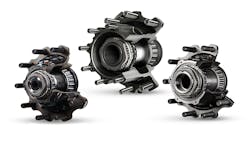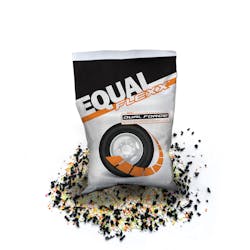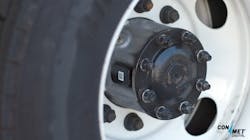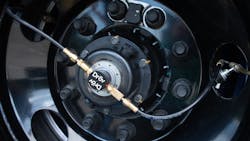Ins and outs of servicing modern wheel-ends
The laborious process required to remedy wheel-end issues has always been a major challenge for technicians. Fortunately, manufacturers have spent the past few decades making wheel-ends easier to install, inspect, and service. Now technology is making its way to the wheel-end, presenting a potential game-changing advancement for heavy-duty technicians to make those tasks even easier.
“We are putting technology right in the hub so a technician already has a pretty good idea of what they need to do as soon as they walk up to that wheel-end,” said Isaac Otto, digital product manager at ConMet, a manufacturer of wheel-ends, hub assemblies, brake drums, rotors, and other products.
Before jumping into the new gadgetry and sensors associated with these improvements, a technician ought to understand the wheel-end system itself. And it’s important to recognize this encompasses more than just the wheel.
“A fleet shouldn’t view a wheel-end as just a hub, spindle, bearings, and seals,” said Rick Domin, principal training and product support at Timken, a manufacturer of wheel-end accessories including hubcaps, hubodometers, and unitized bearing nut systems. “Tires and brakes are part of the picture, too, because everything works together. Bearings affect the seal and the seal affects the bearings. The entire system affects tire wear.”
And along with the material cost of replacing tires, the impact on uptime and safety must also be considered. When it gets down to it, tackling wheel-end issues using all of the tools at your disposal will ensure success for the entire fleet. But to get it right, you have to ask yourself a few questions.
What type of wheel-end is it?
“Not all wheel-end systems are the same,” said Charles Use, senior product manager at STEMCO, a manufacturer of wheel-end and suspension products. “The number and type of components differ from system to system.”
There are generally two types of wheel-ends: manually adjusted and pre-adjusted. Then there are two types of pre-adjusted wheel-ends: unitized and those that utilize a spacer. This is where technicians can run into problems if they aren’t familiar with what they find under the hubcap.
“When you look at either a manually adjusted or pre-adjusted wheel-end, you can’t really tell the difference just by the hardware,” said Roger Maye, national service manager at ConMet. “When you take the hubcap off, you’re going to see a double jam nut or a one-piece spindle nut. Until you get a little further in there to see if it has a bearing spacer, you won’t really know what type you’re dealing with.”
Unitized wheel-ends have their own unique style of hubcap. “Instead of an oil-lubricated wheel-end with a sight glass in the hubcap, it is a solid hubcap with no ability to add lubricant,” Maye explained. “Unitized wheel-ends also have some unique mounting hardware.”
Once a technician recognizes the type of wheel-end system, they can proceed to the appropriate service procedure. This can also be a challenge if they are not familiar with one style or another.
With manually adjusted versions, Maye said technicians should follow TMC RP 618, which outlines eight steps to manually adjust a wheel bearing to the proper end play of 0.001” to 0.005”.
Pre-adjusted wheel-ends are becoming far more common on new vehicles, though. Timken’s Domin said the challenge is that some technicians don’t know what to do with one. When the first wheel-end service rolls around, they don’t recognize what they see.
“Sometimes a technician will just discard what they find and go back to a manual adjust,” Domin said. “We’re trying to educate technicians and even parts counter staff about the advantages of having a pre-adjusted wheel-end, along with the importance of using proper components.”
According to Domin, “proper components” mean high-quality bearings with the proper tolerances for a given application. Proper also means using a reliable spacer on a pre-adjusted wheel-end.
“We don’t recommend the reusing of spacers anymore because they are too subjective to inspect them,” Domin said. “We just recommend replacing with a new spacer. Considering the cost of a new spacer, it is well worth that insurance. Then you need a good seal with the proper amount of lubricant for that specific wheel-end. We don’t care if the technician uses oil or grease, as long as they maintain the proper fill level.”
What are the signs and symptoms of an issue?
Faster identification of wheel-end type should result in faster removal and repair. Further downstream in the system, there are things technicians and drivers should be inspecting for that suggest a potential problem in the wheel-end system.
“A technician might see cracks, rust, and corrosion, as well as steel wheels that aren’t powdercoated or cured correctly,” said David Calzada, a territory manager with IMI Products, a provider of tire, wheel, and fuel-preservation solutions. “A technician may also encounter wheels that aren’t mounted or balanced correctly. The potential consequences range from excessive vibration and tire wear to corrosion-induced wheel failures and even wheel-off incidents.”
With driver pre-trip inspections, it’s important to always check the level and condition of the lube through the sight glass on the hubcap of an oil-lubricated hub, unless the vehicle has unitized wheel-ends that don’t include a sight glass. “You also can’t do that on a drive axle,” ConMet’s Maye pointed out.
“But what the driver or technician can do is look for leaks on the axle flange or around the hubcap,” Maye continued. “Look for dark or rusty streaks coming off of the wheel bolts which indicate a loose fastener. You can also look for broken or missing fasteners. Finally, you can look for signs of a seal leak, which is a matter of looking at the back side of the wheel, the brake system, and the tires for evidence of leaking lubricant. Those are the basics on any wheel-end regardless of type.”
Vibration and temperature are other symptoms to monitor.
“When the vehicle is in the bay and the wheels are off of the ground, we recommend that the technician rotate the wheels to check for smooth operation free of noise and vibration,” Maye said. “The technician can put their hand on the steering knuckle or the brake chamber and check for roughness in the bearings. They can also check for chucking by placing their hand on top of the tire and lifting the wheel assembly with a pry bar to check for loose motion in the wheel bearings. If the technician finds chucking, they can go a little further and check the endplay by physically measuring it.”
Another good thing a driver can do is check the operating temperature of the hub after making a long run without significant braking. Maye said they could use an infrared thermometer or simply hold their hand up to the hub.
Nowadays, technology is helping perform these types of tasks via sensors in the hub without the driver or technician even knowing that it’s happening. More on that later.
What about preventive maintenance?
As STEMCO’s Use pointed out, even if wheel-end components are more maintenance-friendly, they should not be considered maintenance-free. “TMC RP 631C outlines best maintenance practices,” Use said.When performing any wheel-end maintenance, Use said hubs should be thoroughly cleaned and inspected for thread stretch, antilock brake exciter/tone ring damage, and properly sealed bearing cups. “Axles should also be inspected for spindle seal shoulder wear and bearing radius wear that is deforming the seal shoulder,” Use added. “Thread, keyway, or D-flat damage are also commonly observed. Finally, the bearing journals should be examined for excessive wear.”
To help ensure that seals do not fail, it’s beneficial to use a proper installation tool and follow the manufacturer’s recommended installation procedure for that specific seal. The spindle shoulder and hub bore must be properly cleaned, as well.
Air disc brakes are another area for consideration.
“While the main components of a wheel-end system for non-driven axles are the hub, bearings, hub seal, spindle nut, and hubcap, many people also refer to the drum or air disc brake system as part of the wheel-end,” said Mark Holley, director of marketing and customer solutions for wheel-end at Bendix Commercial Vehicle Systems, a developer of active safety technologies, air brake charging, and control systems for commercial trucks.
As Holley pointed out, a common problem with a wheel-end is hub seal failure. If a seal fails and the level or quality of lubrication degrades, the bearings may be severely impacted by the increased friction and heat.
“Bearing failure leads to increased vibration in the wheel-end which can negatively impact brake system components,” Holley added. “Additionally, if the sealing components are damaged, wheel seal lubricant can splash onto the brake friction which can impact braking performance. In a worst-case scenario, bearing failures can lead to wheel-off situations.”
“As air disk brakes become more widely utilized, it is imperative to select a high temperature-rated seal that can withstand the additional heat created during braking,” STEMCO’s Use concurred. Examples of such seals are STEMCO’s Discover and Guardian HP.
With respect to the bearings, Use said failure is most frequently caused by either a lack of lubrication or over-torquing. “Bearings must always be lubricated prior to torquing,” Use explained. “Additionally, if a bearing has been dropped onto the ground prior to installation, it should be discarded due to potential damage to the cage.”
When it comes to fasteners, Use said technicians should always follow the manufacturer’s recommended installation procedures because there is such a wide variety available. Technicians can also consult TMC RP 618B.
A proper hubcap also plays a role in wheel-end longevity. “Fleets should make sure they are properly vented,” Use said. It’s also important to select the right material composition to help resist corrosion. “Depending on a fleet’s area of operation and weather environment, composite materials may be a better selection than metals,” Use added.
Finally, selecting the right lubricant for the application is critical.
“Choosing a lubricant that maintains its chemical properties at your operating temperatures ensures long life of the wheel-end,” Use said. “Getting the proper level of lubricant in your wheel-end is also important. TMC RP 631C is your definitive guide to best lubrication practices. When using a semi-fluid lubricant, it is imperative that the hub cavity be filled to 50%. You can utilize a fill template to simplify this process.”
Tools and technology help monitor wheel-ends
According to Timken’s Domin, it is hard to just generally say wheel-ends should be inspected every 30,000 or 50,000 miles, for example. Some fleets inspect them every time a vehicle comes in for a PM. The challenge is that PM intervals, in many cases, have been extended significantly due to longer oil drain intervals. A technician could use some assistance in alerting them to a potential wheel-end issue that needs to be investigated.
Timken added a new product a couple of years ago to help. Hot Dots are little sticker-like objects that adhere directly to the wheel hub or hubcap. The white circle in the center will turn black when wheel-end temperature exceeds 250°F. “That could be due to a lack of lube, a bearing issue, or even an issue with the brakes,” Domin pointed out. “Regardless, that wheel-end got really hot and should be inspected.”
Taking things one technological step further, a telematics sensor can actually monitor hub temperature while the vehicle is in operation. It can also monitor vibration. “This is the next step in the wheel-end evolution that goes beyond what pre-trip and PM inspections can cover,” ConMet’s Maye said.ConMet’s PreSet Plus SmartHub is an emerging telematics technology that algorithmically processes data captured from the wheel-end. SmartHub starts with a wireless sensor mounted to the barrel of the hub right above the outer bearings.
“That sensor measures both the temperature of the hub and the vibration signatures coming off of the hub,” ConMet’s Otto said. Backend algorithms analyze the temperature and vibration data. “SmartHub will determine when an abnormal behavior is happening and what the potential failure modes could be,” Otto added. SmartHub even directs the technician to the wheel position where the issue is occurring.
With respect to the bearings, for example, vibration patterns might increase over time when a bearing becomes fatigue-spalled. This data could help a fleet take proactive action and inspect the hub before a failure occurs.
Otto said he has also been pleasantly surprised to find that SmartHub can help detect not only issues inside the hub, but also issues with other hub-connected components such as tires and braking systems.
“For example, there are different vibration signatures for different types of tire wear,” Otto explained. “Another example is a stuck brake caliper that is heating up the hub. When you look at the hub temperature and vibration data relative to braking data, you can start to pinpoint issues like this. All of this helps fleets make better maintenance decisions based on what is actually happening with a vehicle, as opposed to just mileage intervals.”
Another tool is Bendix’s air disc brake wear sensing technology that determines when a pad is nearing its replacement period. The sensor provides a signal via telematics that fleets can use to proactively schedule maintenance before a more costly braking system component failure occurs.
Don’t neglect your trailers
Fleets shouldn’t forget about the eight opportunities for wheel-end issues trailers haul to the table.
Drōv Technologies offers multiple wheel sensors that integrate on its AirBoxOne telematics solution for trailers. These sensors can help catch a variety of issues that could point to a wheel-end problem.
The SKF Wheel-end Monitor installs on the lug nuts of each wheel-end and communicates wirelessly via Bluetooth. “This sensor measures temperature of the hub,” said Pete Jankowski, chief technology officer at Drōv Technologies. “Overheating could be the result of a hub bearing that lacks lubrication, brakes overheating, or other hub bearing-related issues. The SKF sensor also monitors vibration at the wheel-end, which can indicate potential issues with the hub such as loose lug nuts or studs, an over-torqued or loose axle nut, or even the potential wheel separation from a failing hub.”An AirBoxOne TPMS Sensor has two installation options: externally to the Shrader valve of the tire or internally on the rim. Regardless, this sensor can help the fleet pinpoint other wheel-end-related issues. “Besides monitoring tire pressure, TPMS sensors can measure the air temperature inside the tire,” Jankowski explained. “High temperature can indicate potential problems with the hubs, imbalanced brakes, and tire alignment.”
AirBoxOne also offers wheel-end sensors that monitor brake-related behaviors. This data helps fleets catch things like pad wear, brake dragging, and air pressure.
Final thoughts
Whether you’re talking about a trailer or a tractor, today’s world of extended PM cycles is putting more pressure on drivers with respect to pre-trip inspections. ConMet’s Maye said having the ability to digitally monitor wheel-ends is more important than ever.
“A driver can’t see what’s going on inside of that wheel-end,” Maye said. “Thanks to technology, now these wheel-ends can be inspected in real time while traveling down the road.”
Beyond hub temperature and vibration, ConMet has a suite of new products and services that monitor things like tire pressure, axle load, and trailer line pressure. Others in the pipeline will help monitor things like lube quality and stud tension.
“All of these things are important to the health of the wheel-end,” ConMet’s Otto said. “This is where things can get really interesting where we can do more with our algorithms in the background to really pinpoint the real issues. Then a fleet can move more toward a predictive state of wheel-end maintenance.”
About the Author

Gregg Wartgow
Gregg Wartgow is a freelancer who Fleet Maintenance has relied upon for many years, writing about virtually any trucking topic. He lives in Brodhead, Wisconsin.



